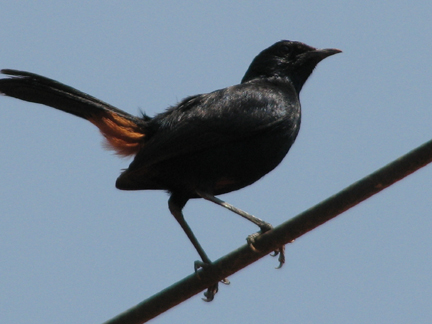Indian Robin. ( Saxicoloides fulicata )
-Ragoo
Rao
The Indian Robin is the Bird of the month for our readers.
The loveable little bird of suburban and rural areas. As urban areas are being expanded a lot of Indian robin territory is being destroyed. However the little bird thrives well in rural areas specially in scrub jungle areas.

A sparrow sized black bird with a white patch on the wings and a rusty colored patch at the base of the tail which is constantly twitched,
is the Indian Robin. A mature male is more iridescent on the neck and head with glistening black feathers. The female is a dull brown with slightly darker wings and about the same size as a male. About five races have been identified with a slight variation
in coloration depending on the habitat.
Distribution is throughout the country upto an altitude of 5000 ft. These birds are peace loving but are very bold. They come into compounds
in the rural areas and approach very close to humans to pick up morsels of food from the ground. Scrub jungles around villages is their mainstay and are not seen in very heavily wooded areas. The fence lines are the favourite perches for the males to sit and
give out their cheet.....cheet...cheey...calls twitching their tails after every note. The females will be closeby and are very shy of humans.
Main food is insects and their eggs. They are specially fond of migrating termites and will keep hunting them even at twilight. Their typical habit is to keep hopping
on the ground looking for insects and whenever they find a rock or a termite mound to hop on it and sing a chee...chee...chee song all the time twitching their tails and again continue foraging.
The breeding season is from April to June in the Southern part of the country. A male selects the nesting site usually in earth banks, rocky
crevices and very often inside the pots kept as scarecrows by the farmers. The nest is made up of grass roots, and a central cuplike pads of grass. Feathers are lined for softness and some nests have also had shed snake skin.
2 to 3 creamy white eggs tinged greenish and speckled with brown patches are laid.
Only the female is observed to incubate but the male shares all other domestic chores.
A very bold loveable bird, the Indian Robin needs its own space to thrive.
As urban expansion grows their territory is getting smaller. But the rural folk never harm these birds. In fact some farmers even provide them nesting sites by keeping an earthen pot with a hole to enter on fence posts and some even put up a post and
place an earthen pot for these birds to nest.
Let us do our might to keep these Birds along with us for a long time.
I hope the article is well timed as a lot of Indian Robins are found nesting these days. Any of our readers, if they have a dwelling close
to the suburbs and if they find these birds around could provide them a nesting place by keeping an earthen pot with a hole on a small post about 4 to 5 feet tall. It is sure to be chosen by these birds.